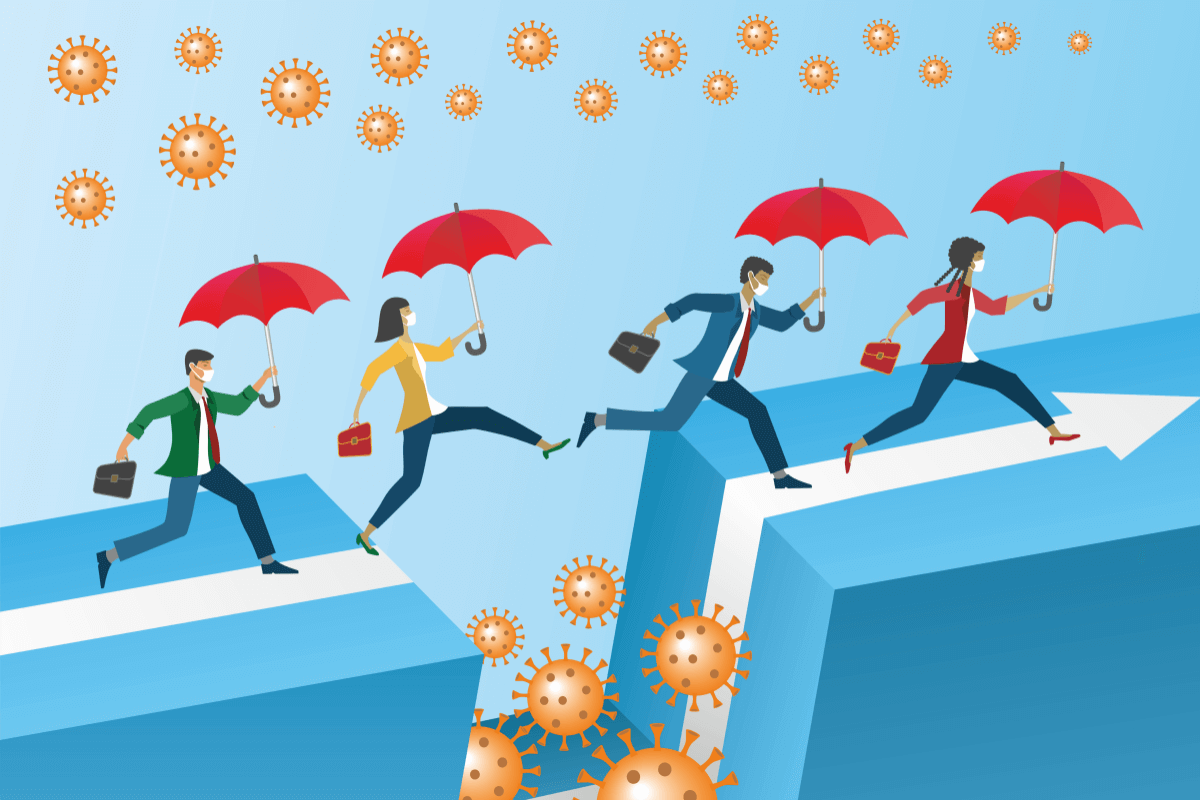By the SMU Digital Marketing Team
Covid-19 lockdowns and the subsequent social isolation have taken a significant toll on the population and economy, with people worldwide feeling the strain of the pandemic on their financial, mental and physical health. But now that restrictions are slowly easing, with signs of discretionary mobility increasing globally, we face the reality of Covid-19 being ever-present in our midst and the challenges of transitioning out from a pandemic into an uncertain new normal.
Unfortunately, issues in the community that were exacerbated by the pandemic will not be easily resolved in the short term, even as we resume social activities. For example, while unemployment rates in Singapore dropped to 4.1 per cent for citizens in April 2021 from an average of 5.19 per cent in 2020, Covid-19 has impacted certain groups — such as older people and lower-income families — more profoundly. Case in point: rent as a percentage of household income more than doubled pre- and post-Covid-19, from 7 per cent to 19 per cent, according to applicants for the Covid-19 Family Assistance Fund by charity Beyond Social Services.
Even with the majority of the population vaccinated, the effects of the pandemic remains considerable, especially with a rapid rise in the number of new infections as restrictions are lifted. Here are some areas that are bearing the brunt of the pandemic for the long haul, and ways in which they can be mitigated with awareness and action from the society as a whole:
Longer-term economic fallout
While the economy may start to recover, not everyone can expect an immediate boost to their financial situation. When government relief initiatives and business bailouts begin to dwindle, will we see the true effects of the pandemic-driven fallout?
For example, Greatearth Corporation, a former Singapore Exchange-listed construction company, recently went under while working on five Build-To-Order (BTO) public housing projects. The impending liquidation of such an established company — Greatearth constructed Mount Elizabeth Hospital, Ngee Ann City and the Marina Bay Sands Hotel — prompts industry watchers to wonder about the fate of other construction companies once the relief period under the Covid-19 Temporary Measures Act for construction projects, supply contracts or any performance bonds comes to an end.
Besides construction, sectors like retail have also been badly hit by the pandemic, with department stores sales declining by 9.2 per cent year on year in July 2021 and that of restaurants by 21.6 per cent. These bleak statistics follow the closures of department store Robinsons and online retailer Naiise in the past year and the current provisional liquidation of luxury resale retailer Reebonz.
“Bankruptcies don’t cause damage to the economy. The damage has already occurred when the bankruptcy is filed. Higher bankruptcies is more a symptom of economic harm than the cause.”
According to a consultant to the American Bankruptcy Institute, Ed Flynn, in an interview with The Washington Post: “Bankruptcies don’t cause damage to the economy. The damage has already occurred when the bankruptcy is filed. Higher bankruptcies is more a symptom of economic harm than the cause.”
Besides the wave of bankruptcies being symptomatic of greater economic distress, the resulting loss of jobs and decline in the supply of services and goods in the market may have a negative multiplier effect, causing even longer-term fiscal problems for the country and its residents.
On a brighter note, the Ministry of Trade and Industry (MTI) upgraded Singapore’s GDP growth forecast for 2021 to “6.0 to 7.0 per cent“, from “4.0 to 6.0 per cent”, and the government has expanded its slew of relief programmes, including the Covid-19 Recovery Grant (Temporary) (CRG-T), which supplements the existing Covid-19 Recovery Grant (CRG) to support lower- to middle-income workers and self-employed people affected by the pandemic. Hopefully, as employment rates rise and disposable income increases, there may be a gradual recovery in the economy.
Environmental effects
Although the pandemic had caused carbon emissions to drop in the short term due to a pause in manufacturing, the economic downturn, and a decrease in commutes as we worked and studied from home, the UN has announced that reduction targets for emissions are still not being met. Governments and the private sector are far from reaching their environmental pledges, with every G20 country failing to meet its 2015 Paris Agreement obligations, a problem perhaps fuelled by current global economic constraints.
Furthermore, in what is now being called a historic collapse of crude oil prices, which came about partly due to the economic shock of Covid-19, distressed fossil fuel companies are now passing the environmental burden of their trade to government bodies — resulting in a potential ecological crisis. Oil wells and mines abandoned by distressed fuel companies are left to governments to plug or clean up, a process that could cost an estimated US$16 billion to execute. Even before the pandemic in 2018, over 3.2 million abandoned oil and gas wells emitted 281 kilotons of methane in the US alone. There are also an estimated 29 million wells around the world polluting our air and water.
Hopefully, the call for a pandemic green recovery — whereby economies are brought out of recession through redesign to reduce greenhouse gas emissions, create jobs, increase the resilience of infrastructure and communities, and prioritise equity, will gain momentum as the global downturn reverses, resulting in systemic change to tackle a very current climate crisis.
Ongoing stress of the new normal
Although severe restrictions and lockdowns will be less common as the pandemic eases, making the transition back to daily interactions and the “new normal” nevertheless will not be easy.
Rather than snapping back to “business-as-usual”, children and youths who face the anxiety of returning to school, and individuals may struggle with new changes from the financial pressures of returning to work (such as the need for affordable childcare options now that one no longer can work from home), psychological distress such as Covid-19 Anxiety Syndrome, or post-traumatic stress disorder for those who had contracted the virus or lost a loved one to the virus.
Other mental health issues such as obsessive-compulsive disorders, which may have heightened during the pandemic due to a lack of mobility, interpersonal tensions and the community-wide call for increased hygiene practices, may also linger even post-Covid. Not to mention the physical ailments associated with “Long Covid”, which sees patients suffering from symptoms three to nine months after contracting the virus.
“The current global health crisis also reminds us that what affects the human family has to be addressed by all of us.”
“The current global health crisis also reminds us that what affects the human family has to be addressed by all of us,” said the Dalai Lama to the BBC, in a series asking global thought leaders about the biggest questions we should be asking as we move toward a post-pandemic society.
In other words, while we all are experiencing challenges in varying degrees, there needs to be an awareness that thriving post-pandemic is a collective effort, not just our leaders’ responsibility. By first accepting that normalcy is a shifting and problematic term and finding the resilience to face a very uncertain future, we could begin to reframe our mindsets and work together on solutions to help our community regain its well-being as one.
After all, if there is anything this pandemic has taught us about the human population, it is that our resilience and hopefulness have helped us define one new normal upon another – and that we are unlikely to stop until the day we see the last of Covid-19.








